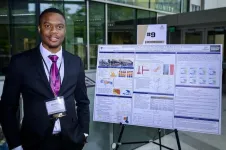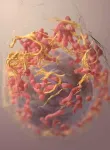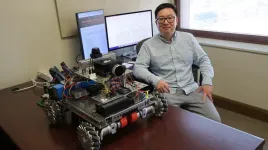(Press-News.org) Over the past two decades, Haiti has endured the devastation of two catastrophic earthquakes — first in 2010 and again in 2021. Each disaster left behind widespread destruction: buildings reduced to rubble, entire communities displaced and an overwhelming loss of life. A major factor in the severity of these tragedies was the widespread structural failure of poorly designed buildings, many of which were not constructed to withstand the powerful tremors.
Marc-Ansy Laguerre, a postdoctoral associate in civil and environmental engineering at Rice University, is determined to change that.
Having grown up in Haiti, Laguerre witnessed firsthand the devastation caused by these natural disasters. He says living through the 2010 earthquake, which claimed an estimated 300,000 lives, reinforced his commitment to helping build a safer future for his country.
His academic path has been laser-focused on this mission. Before attending Rice as a graduate student and now a postdoc, Laguerre earned a bachelor’s degree in civil engineering from the State University of Haiti then attended the University of Pittsburgh as a Fulbright Scholar, earning a master’s degree in civil engineering and a graduate certificate in Latin American studies. Laguerre said he hopes to work in earthquake mitigation and education to protect vulnerable communities from future disasters.
At Rice, Laguerre has found a mentor in Reginald DesRoches, an internationally recognized structural engineer and earthquake resilience expert. Now the university’s president, DesRoches previously served as the William and Stephanie Sick Dean of Engineering at the George R. Brown School of Engineering and Computing, the role he held when Laguerre arrived at Rice.
Born in Port-au-Prince, Haiti, DesRoches said he felt an immediate connection with Laguerre and recognized his potential early on. Even after assuming the presidency in 2022, he has remained actively involved as Laguerre’s adviser.
“Marc is deeply committed to building a more resilient Haiti, and his passion for earthquake mitigation is both inspiring and essential,” DesRoches said. “His dedication to using engineering to protect communities from future disasters reflects the kind of leadership and innovation we need in this field. I have no doubt that his work will make a lasting impact.”
Haiti’s seismic vulnerability
Together with Mohammad Salehi of the engineering firm Simpson Gumpertz & Heger, Laguerre and DesRoches conducted a comprehensive numerical analysis to assess the seismic vulnerability of reinforced concrete (RC) structures in Haiti. Their research, recently published in Earthquake Spectra, explores cost-effective retrofitting solutions that could help fortify buildings against future earthquakes.
“The level of destruction from these earthquakes is a reminder of the urgent need for stronger, safer construction practices in Haiti,” Laguerre said. “Unfortunately, many buildings, especially those constructed before 2010, were not built with seismic resilience in mind.”
The study focused on common structural weaknesses in Haitian RC buildings, which are prevalent in both residential and commercial construction. Many of these buildings suffer from insufficient column reinforcement, poor concrete quality and a lack of lateral load resistance — design flaws that make them highly vulnerable to collapse.
“Haitian buildings were largely constructed without seismic codes in place,” Laguerre said. “Many of them rely on weak columns with minimal reinforcement, which means they cannot properly absorb earthquake forces. When the ground shakes, these structures collapse instead of flexing or redistributing energy.”
Engineering solutions
To determine the most effective retrofitting methods, Laguerre, DesRoches and Salehi created detailed 3D computer models of four common Haitian building types ranging from single-story homes to multistory commercial structures. Using advanced engineering software, they simulated earthquake forces and tested five different retrofitting techniques:
● RC jacketing — adding reinforced concrete around existing columns to strengthen them.
● RC shear walls — thick concrete walls that provide additional lateral support.
● Steel braces — rigid frames that help buildings absorb seismic forces.
● Buckling-restrained braces (BRBs) — specially designed braces that flex without breaking.
● Prestressed high-strength steel cables — tensioned cables that reinforce structures.
The goal of these retrofits was to bring buildings to a Life Safety Code performance level, meaning that while structures could sustain damage during a major earthquake, they would remain intact and prevent catastrophic collapse.
“To evaluate the effectiveness of each retrofit strategy under real seismic conditions, we applied 11 simulated ground motions — one of which was recorded in Haiti — representing the Earth’s surface movement during an earthquake,” Laguerre said.
The team found that all five retrofitting techniques improved seismic performance, but their effectiveness varied depending on the building type.
For residential buildings, the best results came from using steel braces combined with RC jacketing, which significantly reduced structural movement during an earthquake.
“Steel braces are a practical and relatively low-cost way to strengthen homes,” Laguerre said. “When combined with RC jacketing, which reinforces the existing columns, it creates a much stronger structure.”
For larger, nonresidential buildings, BRBs and shear walls proved to be the most effective solutions. These reinforcements helped distribute earthquake forces more evenly, reducing the risk of collapse.
“For schools, hospitals and government buildings — places where structural failure would be disastrous — adding BRBs or shear walls should be a priority,” Laguerre said. “These global retrofit techniques substantially reduced interstory drift demands, decreasing the risk of collapse.”
A roadmap for a safer Haiti
The study’s findings have significant implications for Haiti’s disaster preparedness strategy. With limited resources, the country needs retrofitting solutions that are both effective and cost-conscious.
“We can’t prevent earthquakes, but we can prevent buildings from collapsing,” Laguerre said. “This research provides a roadmap for making existing structures safer while keeping costs manageable.”
Beyond engineering solutions, the team stressed the importance of policy changes and education initiatives to promote safer construction practices.
“These findings can inform building codes and guide engineering practices for safer construction,” Laguerre said. “We want to create lasting changes so that when the next earthquake strikes, Haiti will be better prepared to withstand it.”
END
Building a safer future: Rice researcher works to strengthen Haiti’s earthquake resilience
2025-03-18
ELSE PRESS RELEASES FROM THIS DATE:
Diverging views of democracy fuel support for authoritarian politicians, Notre Dame study shows
2025-03-18
Why do people living in democratic countries vote for political candidates who openly violate democratic standards? A new study by a University of Notre Dame researcher found that diverse understandings of democracy among voters can lead to votes for authoritarian-leaning political leaders.
“A considerable variety in democratic views leads part of the electorate to overlook violations of democratic norms such as minority rights protection or restraints on executive power,” said Marc Jacob, assistant ...
Bacteria invade brain after implanting medical devices
2025-03-18
CLEVELAND—Brain implants hold immense promise for restoring function in patients with paralysis, epilepsy and other neurological disorders.
But a team of researchers at Case Western Reserve University has discovered that bacteria can invade the brain after a medical device is implanted, contributing to inflammation and reducing the device’s long-term effectiveness.
The groundbreaking research, recently published in Nature Communications, could improve the long-term success of brain implants now that a target has been identified to address.
“Understanding the role of bacteria in implant ...
New platform lets anyone rapidly prototype large, sturdy interactive structures
2025-03-18
CAMBRIDGE, MA – Prototyping large structures with integrated electronics, like a chair that can monitor someone’s sitting posture, is typically a laborious and wasteful process.
One might need to fabricate multiple versions of the chair structure via 3D printing and laser cutting, generating a great deal of waste, before assembling the frame, grafting sensors and other fragile electronics onto it, and then wiring it up to create a working device.
If the prototype fails, the maker will likely have no choice but to discard it and go back to the drawing board.
MIT researchers have come up with a better way to iteratively design large and sturdy ...
Non-genetic theories of cancer address inconsistencies in current paradigm
2025-03-18
It’s time for researchers to reconsider the current paradigm of cancer as a genetic disease, argued Sui Huang from the Institute for Systems Biology, USA, and colleagues in a new essay published March 18th in the open-access journal PLOS Biology.
The prevailing theory on the origin of cancer is that an otherwise normal cell accumulates genetic mutations that allow it to grow and reproduce unchecked. This paradigm has driven large-scale cancer genome sequencing projects, such as The Cancer Genome Atlas, to identify cancer-driving mutations ...
Food and non-alcoholic drink products in Mexico were substantially reformulated to be healthier following the 2020 introduction of warning labels identifying products with excessive content of calorie
2025-03-18
Food and non-alcoholic drink products in Mexico were substantially reformulated to be healthier following the 2020 introduction of warning labels identifying products with excessive content of calories, fat, salt, sugar, sweetener and caffeine
In your coverage, please use this URL to provide access to the freely available paper in PLOS Medicine: http://journals.plos.org/plosmedicine/article?id=10.1371/journal.pmed.1004533
Article title: Product reformulation in non-alcoholic beverages and foods after the implementation ...
Conservation efforts are bringing species back from the brink, even as overall biodiversity falls
2025-03-18
A major review of over 67,000 animal species has found that while the natural world continues to face a biodiversity crisis, targeted conservation efforts are helping bring many species back from the brink of extinction.
The study draws on data from the IUCN Red List, the world’s largest database of species conservation status. The researchers say their results, reported in the journal PLOS Biology, highlight both the successes and the need for urgent action.
The world is facing a global biodiversity crisis, with 28% of more than 160,000 assessed species threatened with extinction, and an estimated one million species facing this fate due to human activities. ...
Conservation efforts analysis reveals which actions are most helpful for endangered species status
2025-03-18
Targeted conservation actions are essential to prevent wildlife extinctions, but more efforts are needed to fully recover biodiversity, according to a study published March 18th in the open-access journal PLOS Biology by Ashley Simkins of the University of Cambridge, UK and colleagues.
Out of over 166,000 species assessed by the International Union for Conservation of Nature, around 28% are threatened with extinction. Global efforts to prevent extinction and recover biodiversity have had some success, but there is limited data to show which conservation actions are most effective. In this study, Simkins and colleagues compile information ...
JSCAI special issue explores the transformative role of artificial intelligence in interventional cardiology
2025-03-18
WASHINGTON —The Journal of the Society for Cardiovascular Angiography & Interventions (JSCAI) proudly announces the publication of a groundbreaking special issue: The Role of Artificial Intelligence in Cardiovascular Interventions.
This issue explores how artificial intelligence (AI) is revolutionizing interventional cardiology, from diagnostic precision to procedural planning and patient outcomes. It features a collection of original research, reviews, and viewpoints that delve into AI’s applications across ...
Wayne State University research making strides in autonomous vehicle and machine systems to make them safer, more effective
2025-03-18
DETROIT — A grant to Wayne State University from the National Science Foundation (NSF) is opening new doors for researchers and students to explore the future of autonomous vehicles, machines and drones.
Zheng Dong, Ph.D., assistant professor of computer science in Wayne State’s School of Engineering, was awarded a five-year, $595,611 NSF grant for the project, "CAREER: ChronosDrive: Ensuring Timing Correctness in DNN-Driven Autonomous Vehicles with Accelerator-Enhanced Real-Time SoC Integration."
“We ...
Thorny skates come in snack and party sizes. After a century of guessing, scientists now know why.
2025-03-18
When Jeff Kneebone was a college student in 2002, his research involved a marine mystery that has stumped curious scientists for the last two decades. That mystery had to do with thorny skates in the North Atlantic. In some parts of their range, individuals of this species come in two distinct sizes, irrespective of sex, and no one could figure out why. At the time, neither could Kneebone.
In a new study, Kneebone and researchers from the Florida Museum of Natural History say they’ve finally found an answer. And it’s all thanks to COVID-19.
People have known about the size discrepancy in thorny skates for nearly a century, but it became critically ...











